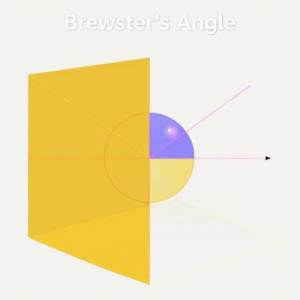Brewster’s Angle is the specific angle at which light with a particular polarization is perfectly reflected when it hits a surface. In simple terms, it’s the angle at which light is most efficiently polarized upon reflection.
- Named after: The Scottish physicist Sir David Brewster who discovered this phenomenon.
- Occurrence: It happens when light hits a surface (like glass or water) at a specific angle.
- Result: At this angle, the reflected light is completely polarized, which means all of its light waves oscillate in one direction.

How does it work?
When light strikes a surface (like the surface of water, glass, or any transparent material), some of it is reflected, and some of it passes through (refracted).
- At Brewster’s Angle, the reflected light is completely polarized. This means the reflected light vibrates in only one direction (not in multiple directions as normal light does).
- The angle of incidence (the angle at which the light hits the surface) that gives this effect is called Brewster’s Angle.
Formula for Brewster’s Angle
The formula to calculate Brewster’s Angle (
) is:
Where:
is the Brewster’s Angle.
is the refractive index of the first medium (usually air).
is the refractive index of the second medium (the material the light is striking, like glass or water).
For example:
- If light is hitting the surface of water (refractive index of
) from air (refractive index
), the Brewster’s Angle would be calculated as:
This means that when light strikes the water at an angle of about 53 degrees, the reflected light will be fully polarized.
Malus’ Law
What is Malus’ Law?
Malus’ Law describes how the intensity of polarized light changes when it passes through a polarizing filter. It explains how the brightness of light changes based on its polarization direction relative to the orientation of the polarizer.
- Named after: The French physicist Étienne-Louis Malus, who formulated this law.
- What it tells us: Malus’ Law tells us how the intensity of polarized light decreases when it passes through a polarizing filter.
How does it work?
- When light is polarized, it means the light waves are vibrating in only one direction.
- If you pass this polarized light through a filter (called a polarizer), the intensity of the light that comes out depends on the angle between the light’s polarization direction and the axis of the polarizer.
- If the polarizer’s axis is aligned with the polarization direction of the light, the intensity will be maximized.
- If the polarizer’s axis is perpendicular to the polarization direction of the light, the intensity will be zero (no light passes through).
Malus’ Law Formula
The law is expressed by the following formula:
Where:
is the intensity of the light after passing through the polarizer.
is the initial intensity of the polarized light before passing through the polarizer.
is the angle between the light’s polarization direction and the axis of the polarizer.
What does this mean?
- If
(the light’s polarization direction is aligned with the polarizer), the intensity will be maximum, and
.
- If
(the light’s polarization direction is perpendicular to the polarizer), the intensity will be zero, and no light will pass through.
Examples:
- Sunlight and Polarized Sunglasses:
- Sunlight is unpolarized, but when it reflects off surfaces like water or roads, it becomes partially polarized.
- Polarized sunglasses are designed to block the horizontally polarized light (light reflected from water or the road). By using a polarizing filter (the lens), the sunglasses reduce glare and allow only vertically polarized light to pass through.
- Malus’ Law explains how the light intensity is reduced when it passes through the polarizing filter, depending on the angle of the light’s polarization.
- Photography and Optical Instruments:
- Polarizers are used in photography to reduce reflections from water or glass, and in optical instruments to enhance contrast by filtering out unwanted light. The angle of the polarizer relative to the polarized light will affect how much light passes through.
Key Differences:
- Brewster’s Angle: Deals with the angle at which light is reflected and becomes completely polarized.
- Malus’ Law: Deals with how the intensity of polarized light changes when it passes through a polarizing filter.
In Summary:
- Brewster’s Angle: The angle at which light is reflected in a way that makes the reflected light fully polarized.
- Malus’ Law: A formula that explains how the intensity of light changes when polarized light passes through a polarizing filter.











